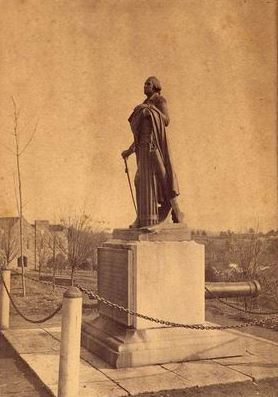
Side profile of the statue
Dedicated on the grounds of the Virginia Military Institute, on July 3, 1856, William James Hubbard’s copy of Jean Antoine Houdon’s Washington had, for eight years, been a point of inspiration to cadets of the Institute, and, to the residents of Lexington, a proud reminder of the “Father of the Country”. Therefore, when returned to the grounds of the Virginia Military Institute, twenty-seven months after it was seized by Union soldiers, it was no small affair. Yet, one would be challenged to find mention of the individual who was key in the return of the statue. As Cecil D. Eby, Jr. notes in his biography of David Hunter Strother (aka, “Porte Crayon”), Strother was compelled by a sense of duty, but, in returning the statue, “had no intention of appeasing the South.” Eby continued:
His spirit of justice and frankness was not a reflection of obsequious pacification. The North, not the South, must determine what is owed and who should pay. As we have seen, when [Gen. David] Hunter destroyed V.M.I., a statue of Washington had been seized as a prize of war. Along with it went two bronze cannon. While Strother was adjutant general, authorities of the school requested the return of these trophies. He at once complied with part of the request and the statue was returned.
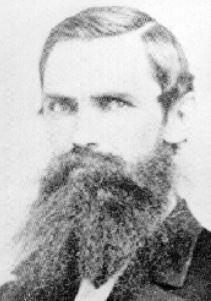
Strother, the civilian.
In a letter to Gov. A.J. Boreman, of West Virginia, Strother wrote:
The war is ended. The great Cause has triumphed gloriously. Peace covers the land with her healing wings. The military institute phoenix like is rising from its ashes. Its mission hereafter will be more peaceful and more in accordance with the spirit of the age… With such views and aims for the future, the statue of George Washington can with great propriety resume its position as patron of the Institute and under these circumstances we wish to replace it.
Despite Strother’s deliberation in seeing to the return of the statue, Virginians did not recognize the efforts. Wrote Eby, “It is regrettable that Strother’s part in capturing it rather than in returning it has most often been alluded to by Virginians.”
Strother’s involvement aside, on July 10, 1866, the Staunton Spectator, carrying over a story (dated July 7) from the Alexandria Gazette, made note of the statue’s impending return:
The following dispatch would lead us to believe that the “restoration policy” has been inaugurated: The statue of George Washington, removed from the Virginia Military Institute, Lexington, Virginia, arrived in Alexandria yesterday, from Baltimore, by the National Express Company, and will be forwarded by the same agency tomorrow, to Lynchburg, from whence it will be returned to Lexington.
Clearly, the lack of recognition for Strother’s efforts (if they were even truly aware of them) is evident in the Virginia newspapers. It should be no surprise then, that Strother’s sense of duty in the matter is equally without detection. As Eby implies, Strother is essentially snubbed, even though he also happened to serve an ex officio member of VMI’s board of visitors (by virtue of his position as adjutant general to Francis H. Pierpont, governor of “restored” or loyal Virginia).
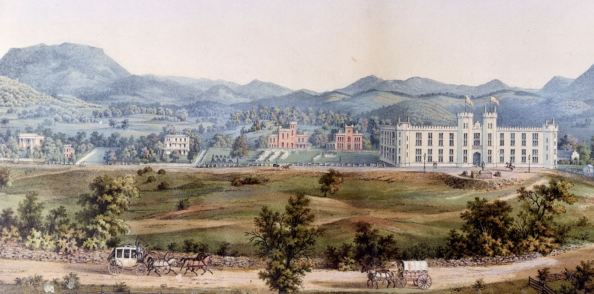
Casimer Bohn’s “A View of the Virginia Military Institute”, ca. 1857. The statue of Washington can be seen on the far right, in front of the entrance (then) of the barracks.
Nonetheless, the return of the statue to Lexington and V.M.I. was a huge event, especially with rumors that Gen. Ulysses S. Grant himself would be present. On September 3, 1866, the Richmond Dispatch reflected the buzz that must have been all around Lexington:
The session of the Institute commences on the 13th of September. All the cadets are expected to be there on the 10th to take part in the ceremonies of the inauguration of HUBARD’s copy of HOUDON’s statue of WASHINGTON, which was carried off by General HUNTER, but which the Government of West Virginia, manifesting a most creditable spirit, caused to be returned to Lexington. The ceremony of again elevating the statue to its place will be more deeply interesting that that which occurred when it was first installed in the grounds of the Institute. Governor LETCHER, who was a victim of the vandalism of the same General HUNTER, will deliver an address on the occasion.
The interest of the event will be very much enhanced by the presence of Lieutenant-General GRANT on that day, witnessing the installation of the statue of the “Father of his Country,” will be one of the most striking indications of the revived and convalescent nationality of the Federal Union that has yet been presented, and cannot fail to exert a moral influence in favor of the restoration of Peace and Equality to the Union.
The Institute will have a good school in spite of all the obstacles. General [Frances H.] SMITH has been most untiring in his efforts to make preparations for the accommodation of all who desired to come. Twenty-six rooms of the Institute proper are finished, and thirty-four more nearly ready for occupants. We have not a doubt that it will soon be restored to its former prosperity.
We are enabled to add a very gratifying piece of information. General GRANT has not only given arms to the cadets, but restored to them the old Cadet battery. One of the officers of the Institute recognized it at Washington, and asked the General for it. He gave it without hesitation – remarking, in substance, that the rising generation must be educated, and means for that purpose must not have an irresistible force in diminishing sectional prejudice and smoothing the way to the complete restoration of the Union.
Though Grant would actually not show (having sent his regrets via a letter), the day still proved memorable. From the September 12 issue of the Richmond Dispatch:
This day was fixed for the ceremony of the reinauguration of Hubbard’s bronze statue of Washington, presented to the Virginia Military Institute by the State of Virginia. It was taken from its pedestal by Major-General David Hunter on the 13th June, 1864, and by him carried to West Virginia and given to the government of that State, which, being too conscientious and just to approve the defense of this act of vandalism, voluntarily returned it to the Institute and to-day it is restored to its pedestal, where it was originally placed by order of the State of Virginia, a sacred charge to the Institute and the object of the veneration of the people of the village.
The day when the spoiler came, and when he ruthlessly outraged the rights and the devoted affections of this people – the day when he carried off the life-like and almost breathing presentment of the form and figure of the “Father of his Country” – was one of woe to the people of Lexington and Rockbridge. This day of the reinauguration of this venerated figure, so bright, so peaceful and so completely freed from war’s alarms, is indeed in happy contrast to the ever memorable 13th June. Yet, with all the present cheerful influences of the contrast, the sad ruins of the hand of relentless war which still disfigure the scene occasionally blend with the joy of the day sentiments not of the kindliest nature.
The view presented to the eye of the stranger was one of rare beauty. The elevated ranges of mountains, which appear on all sides, seemed to enclose the lovely valley as does a rich frame the picture that is within it. The picture consisted of the beautiful village and the surrounding country with its green fields and peaceful, cheerful homes embowered in trees of richest foliage. The centre of the scene was the barracks of the Institute – the only sad figure in the bright panorama. And this land of industry is fast changing back to its original harmony and beauty.
At half-past ten o’clock the cadets of the Institute were formed into line, about 150 in number, under the command of Colonel Shipp, and escorted the orator of the day, ex-Governor Letcher, the trustees of the college, the Board of Visitors of the Institute, and the professors of both schools to the stand, which was erected in front of the barracks. The statue stood almost forty or fifty feet in front of the stand, and on either side of it were seats prepared for the auditors of the celebration. The stand was occupied by the Rev. Dr. Plumer, and members of the Board of Visitors of the two flourishing institutions of the town. Among the guests General Lee was the observed on all observers. The Board of Visitors of the Virginia Military Institute present were Adjutant-General Richardson, ex-Governor John Letcher, Colonel George W. Bolling, of Petersburg; William L. Owen, Esq., of Halifax, and Colonel M.G. Harman, of Staunton. Before the stand was occupied the seats in front were filled with the Beauty and Intelligence of the town. At 11 o’clock the Rev. D. William S. Plumer offered up a fervent invocation to the Throne of Grace. Ex-Governor Letcher then delivered an address…
After concluding his oration, Governor Letcher addressed the officers and cadets of the institution, informing them that the statue was committed to their care to b gy them guarded and protected.
The statue was then uncovered and found to have received no injury whatever, although in its translation it us understood to have been upset, and to have rolled down a precipice probably one hundred feet. Upon its exposition the cheers of the multitude were vociferous.
The speech of Governor Letcher was well received and heartily applauded at its conclusion – the fair hands of the ladies exerting themselves with considerable energy to swell the plaudits of the multitude. The cadets added to the strong expression of applause three hearty cheers.
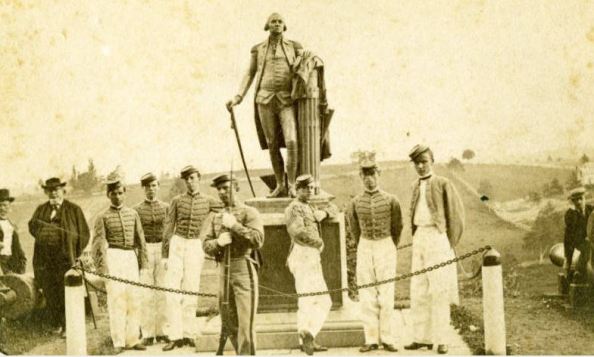
Image of the Washington statue, surrounded by a small grouping of cadets, in 1866. Photo courtesy of the VMI Archives Digital Collections.
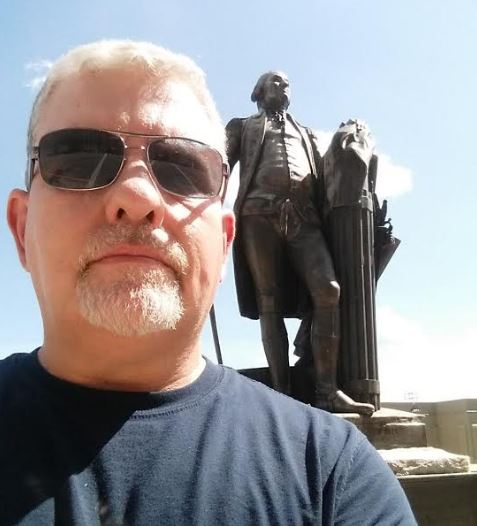
Yours truly, at the Washington statue, July 2016


Posted on September 10, 2016 by The Wild Pretanī
0